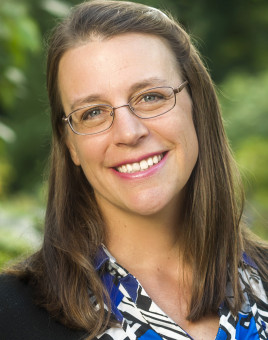
Jessica Kleiss
Associate Professor of Environmental Studies and Director of Environmental Studies Program
I like to explore mathematical ways to describe the world around me. I found my home in Oceanography and Atmospheric Science: the rich natural world surrounds us with swirling eddies, layers of clouds, crashing waves, and meandering rivers of water within giant oceans. As a visual learner, I became interested in developing image processing techniques to investigate the fluid earth using digital images, video, and satellite images.
My current work uses ground-based sensors and digital images to estimate the three-dimensional geometry of shallow cumulus clouds. Ground-based images are one of the best methods to observe these small yet bright and relatively warm clouds. Our description of the cloud geometry can be used to inform and validate weather and climate models.
My dissertation work at Scripps Institution of Oceanography investigated wave breaking in the deep ocean, for example under strong winds or stormy conditions. We evaluated the kinematics (motion) and dynamics (energy and momentum) of whitecaps as the wind blew offshore from the Pacific coast of Southern Mexico. The winds funnel through a gap in the Sierra Madre mountains called the Isthmus of Tehuantepec, resulting in a fascinating environment of wind, waves, upwelling, and mixing. I also did postdoctoral work at the University of Washington with the Joint Institute for Studies of the Atmosphere and Ocean (JISAO) where I studied the influence of the Gulf Stream on satellite observations of wind velocity over the ocean.
Academic Credentials
PhD 2009 Scripps Institution of Oceanography, University of California at San Diego, Physical Oceanography
BS 2000 Massachusetts Institute of Technology, Mathematics
BS 2000 Massachusetts Institute of Technology, Earth, Atmospheric, and Planetary Sciences
Teaching
ENVS 220: Environmental Analysis
ENVS 295: Environmental Engagement
ENVS 330: Situating Environmental Problems and Solutions
GEOL 170: Climate Science
GEOL 270: Oceanography
GEOL 340: Spatial Problems in Earth Systems Science
Research
Kleiss JM, Riley, E., Long, CN, Riihimaki L., Berg L., Morris V. and Kassianov E. 2018. Cloud Area Distributions of Shallow Cumuli: A New Method for Ground-based Images. Atmosphere, 9, vol. 7.
Okita J, C Poor, JM Kleiss, T Eckmann. 2018. Effect of Age on Runoff Water Quality from Green Roofs in Portland, Oregon, Journal of Green Building, 13, no. 2, p. 42-54.
Kassianov E, EA Riley, JM Kleiss, CN Long, L Riihimaki, D Flynn, C Flynn, and LK Berg. 2017. Macrophysical properties of continental cumulus clouds from active and passive remote sensing. Proc. SPIE 10424, Remote Sensing of Clouds and the Atmosphere XXII, 104240A.
Wagner, TJ, JM Kleiss, 2016. Error characteristics of ceilometer-based observations of cloud amount, Journal of Atmospheric and Oceanic Technology, 33, no. 7, p. 1557-1567.
Romero, L., WK Melville, JM Kleiss, 2012, Spectral Energy Dissipation due to Surface-Wave Breaking, Journal of Physical Oceanography 42 (9), p. 1421-1444.
Kleiss JM, WK Melville, 2011. The Analysis of Sea Surface Imagery for White Cap Kinematics, Journal of Atmospheric and Oceanic Technology, 28, p. 219-243
Kleiss JM, WK Melville, 2010. Observations of wave breaking kinematics in fetch-limited seas, Journal of Physical Oceanography, 40 (12), p. 2575-2604
Melville WK, L Romero, JM Kleiss. 2005. Extreme Waves in the Gulf of Tehuantepec. Aha Hulikoa Proceedings p. 23-28.
Riley, EA, E Kassianov, JM Kleiss, CN Long, L Riihimaki. Spatial cloud uniformity as a predictor for multi-instrument cloud cover agreement. In preparation.
Kleiss JM, L Garrett. The effect of image distortion, resolution, and obstructions on automated cloud type classification of whole sky images. In preparation.
Location: Olin Hall
Environmental Studies is located in room 343A of John R. Howard Hall on the Undergraduate Campus.
MSC: 62
email envs@lclark.edu
voice 503-768-7790
fax 503-768-7620
Symposium Advisor Jessica Kleiss
Environmental Studies
Lewis & Clark
615 S. Palatine Hill Road MSC 62
Portland OR 97219
